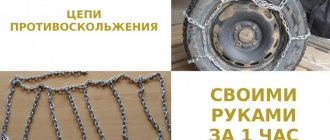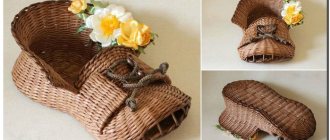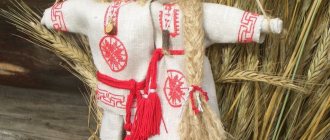Buying a knife made of high-quality steel is, of course, not a problem. If there is not enough assortment of regular or branded blades, you can find a specialist who works on an individual order.
However, you can go another way - make a knife yourself. You most likely won’t be able to forge the perfect blade the first time, but who knows...
A homemade knife made from cable is a worthwhile undertaking; the result can be a high-quality blade with a visible pattern on the blade, formed by mixing layers of metal during the process of forging it.
Material selection
In our time, only true connoisseurs of this craft engage in blade making. However, even a novice blacksmith and anyone can try to forge a homemade knife.
The easiest way to do this is from a piece of thick reinforcement, an old file or a piece of a car spring. It will be a little more difficult to unforge the drill or bearing race. You can get an interesting result from a spun chain from a chainsaw or car engine.
Another material that, after forging, can become a high-quality blade is cable. Its cores are made of carbon steel, capable of holding an edge well after hardening. If you manage to preserve the braided pattern after forging, you can get a very original blade, vaguely reminiscent of wild Damascus steel.
What do you need to know to figure out how to make a knife from rope? Two important nuances: first, whether the properties of the high-carbon material will be preserved during processing; the second is whether a visible pattern will appear on the blade, gracefully turning into a sharpened edge.
Making a knife from a saw with your own hands
Looking at the finished blade, the average person will think – what’s so complicated about it? I sawed it off, sanded it, sharpened it and attached a handle. No. Knife making is a whole science, which gradually often turns into art. A self-made blade has multiple positive qualities:
- the handle is easy to make to fit the palm of the owner of the product;
- there is no need to worry about the quality of the workpiece and the final product;
- It’s not difficult to make a product unique.
Do-it-yourself knife from a saw.
Cutting and primary processing of the workpiece
The initial stage of making a blade from a hacksaw blade, similarly from other materials, is a preliminary sketch. You need to have an idea what the result will be. Marking will help you cut out the workpiece of the required shape:
- right angles should be avoided; the layout must be marked with a small margin of 1.5 - 2.5 mm;
- it is necessary to know the future purpose of the blade; the shape of the sketch directly depends on the role of the product;
- Along the way, it is worth remembering the laws of manufacturing edged weapons.
On our resource, the legislative aspect regarding the carrying of knives is considered separately. Having finished making the layout, you should transfer it to the saw blank. It is necessary to outline with a sharp object; a marker is used only when absolutely necessary. Seeing the contours of the sketch is the main task.
Blank for making a knife from a saw.
Having secured the workpiece in a vice, the future blade is cut along the contour. The part must not be overheated; it is necessary to pour water on it; excessive heating of the steel will lead to brittleness of the product. It is permissible to expose small areas to high temperatures; the margin when marking is made for a reason. It is better to remove them on a sharpening machine.
Rough finishing can be done with files. Having removed the burrs, it’s time to start making the handle. There is no need to harden the blade; factory heat is enough.
Making a handle
The previously made decision on the overhead method of attaching the handle gives full right to use a drill. A drilling machine is a luxury; if you have such a “miracle”, there is no shame in resorting to its help:
- In accordance with the sketch, there is a need to make two or three holes in the shank. Depends on the length of the handle.
- Split the prepared block of wood exactly in half.
- After fitting the wooden blanks to the shank, sand them until they fit tightly. In one of them you should cut a recess for the shank.
- Having perfectly adjusted the parts, holes are made in the wooden overlays.
- Rivets are cut from a copper rod. Final fitting and preliminary assembly.
- Wooden blanks are roughed and adjusted to the anatomy of the owner’s palm.
- Final sanding of the handle, making a brass bolster.
- Assembling the parts of the handle with coating the shank and pads with epoxy glue.
- Driving copper rivets. Drying the product.
Knife handles.
One day is enough for the glue to dry. Use a grinding machine to finally adjust the handle. Sand with fine grit sandpaper.
Trips and sharpening
Finally, the blade is sharpened to meet the necessary needs. The sharpening angle of the RK depends on the purpose of the knife. There are plenty of ways to derive the correct RK.
Previous Making a knife from rapid with your own hands Next Making How to make a knife from a chain with your own hands
Damascus steel
Previously, sharp, flexible and reliable blades with a patterned pattern on the blade were called damask blades (according to one version, from the province of Fulad in Persia, where they were made). Such characteristics and visible effects were achieved using various methods.
Steel could be smelted in a crucible by metallurgical casting, experimenting with the composition of the material. Another option is to “weld” steel strips of different hardnesses in a forge and then forge the resulting workpiece. Blades forged by blacksmiths using a special technique began to be called Damascus.
They differ precisely in the manufacturing method and technology, and not in the characteristics and degree of expression of the pattern. Having unforged a knife from a cable, you can try to create a blade with your own hands that vaguely resembles such material. And although the pattern on the blade is not an end in itself, it is still a distinctive feature of Damascus steel.
Making knives at home
Making a homemade sheath at home includes the following steps:
- making a pattern from paper (you need to put a blade wrapped in tape on it, add 1.5 cm from each edge and circle);
- creating a pattern from leather or thick fabric (the pattern is traced 2 times in a mirror image);
- cutting out from the material 2 side inserts 1.5 cm wide and a T-shaped part, which will then become a clasp;
- processing the edges of the cross element with wax, grinding on a felt wheel of the machine;
- sewing a T-shaped part and one of the main patterns with nylon thread;
- gluing the inserts of this part of the sheath;
- fixing the second half of the pattern with glue;
- turning the edges of the workpiece on a grinding machine;
- stitching glued parts;
- polishing the surface of the sheath, applying cream if it is leather;
- making holes at the ends of the fastener to secure the button parts.
Watch the video about how the knife is made:
Blacksmithing tools and materials
To forge a knife from a cable with your own hands, you need to master the craft of a blacksmith at least at a minimum level. To do this, you will need a pair of hammers: one massive (up to 2 kg), the other lighter (up to 0.5 kg) for fine work, pliers, an anvil and a homemade furnace (forge crucible) with forced air supply.
The manufacturing process cannot be done without a grinder, a sharpening machine, or electric welding. You will need a vice and an adjustable wrench. The fuel for the crucible can be charcoal from rocks that produce great heat, because the workpiece will have to be heated to a temperature of over 1200 ° C.
For better “welding”, you can use borax as a flux. It removes scale and prevents carbon from burning out of the material. It is also necessary to prepare the oil for hardening and ensure safety precautions.
Being able to use someone's blacksmith shop or business forge with a mechanical hammer will make the task much easier.
Working tools and materials
Judging by the reviews of experienced knife makers. You can use any former saw blade as a blank. Two-handed, mechanical saw, band saw, hacksaw for metal or wood - any of the selected options guarantees strength and durability. All of them hold an edge perfectly, thanks to the steel from which they are made.
In the production of saw tools, factory hardening is used. Making a knife from a saw is a labor-intensive process; the workpiece is difficult to process due to the red-hardness of the metal. The effort spent on making the product will more than pay off in the final result.
You will need a tool used in the manufacture of knives:
- electric drill, with a set of drills of various diameters;
- sharpening machine (the presence of this will simplify the work);
- Grinder angle grinder, wheels for various purposes;
- files of various grain sizes;
- ruler, pencil, paper, marker;
- vice, hammer and sandpaper with different grains;
- container with water.
You may need a welding machine to weld the shank. It is necessary to clearly decide on the type of handle - overhead or mounted. Both types are easier to make from wood. Let's focus on the first option. Required materials:
- piece or whole saw;
- wood blocks, epoxy glue;
- a rod of copper, tin, brass or bronze;
- tools for working with wood: core, chisel, etc.
It makes absolutely no difference in what condition the saw blade was obtained. This will not affect the final product.
Preparatory operations
To make a knife from a cable, first of all you need to sketch it out on paper. Then you will have to find a suitable material. It is necessary to check it and at least remotely determine the carbon composition in it.
It depends on this whether the future blade will be hardened, whether it will hold an edge, and whether it will be possible to carry out forge “welding.” The test is carried out for sparks from a grindstone. A moderately dense orange sheaf of them will mean that welding is possible; the steel contains about 1% carbon, which is enough for hardening.
Next you need to cut a piece of cable to the required length. At this stage, the method of manufacturing the handle is determined. It can be made from a single piece of cable without forging. The knife will look original, but have decent weight.
Another option is to electric weld a reinforcement rod to a section of cable. It is convenient to hold on to such a handle when heating the workpiece in the crucible and processing it with hammers. You can then make a handle on it or, by riveting it, install decorative overlays.
Before starting work, the cable is tightened with steel wire clamps in several places. This is done so that during the heating process the thin wires do not unravel.
How to forge a knife from a cable?
The workpiece is placed in the lit crucible and allowed to heat up to 800 °C. At this stage, the cable strands are released (annealing), the material becomes pliable. Additionally, oil and dirt burns out.
After cooling, the workpiece is clamped in a vice and one of the ends of the cable is welded using electric welding. Using an adjustable wrench, it is “tightened” as we weave to maximum density. The other edge is scalded while simultaneously fastening a piece of reinforcement for ease of work.
The wire clamps are removed, the workpiece is heated to 1200 °C, and generously sprinkled with borax. This is necessary for better penetration. After reheating, forge “welding” is performed. Using a heavy hammer, the cable is broken flat and periodically sprinkled with borax.
The workpiece is constantly heating up. The more often this is done, the more intensively the forging occurs, the better the material is “welded.” After rough processing, they move on to forging the blade, the future cutting edge, and the shank. At this stage, a smaller hammer is used more, giving the workpiece an outline reminiscent of a sketch of the future blade.
Complexities of technology
It is necessary to constantly monitor the temperature of the workpiece, not allowing it to cool. Working with a heavy hammer, especially without proper practice and experience, can easily damage the curls of the cable in places where a distinct weave pattern should remain. Unwanted hits with the edge or corner of a sledgehammer on a heated workpiece leave deep dents that cannot always be ground off.
During operation, the process of carbon burning out of the metal is inevitable. There are craftsmen who forge a knife from a cable on dense wood placed on the plane of an anvil. When it comes into contact with heated metal, it smolders, and the oxygen in the air at the point of contact is burned, which reduces the degree of carbon burnout from the material. In addition, by unforging the cable on a tree, you ensure that the workpiece cools more slowly, so you can do a larger amount of work in one cycle.
We forge a knife from a drill ourselves
Drills are often used to forge knives. This is due to the fact that these products are made of R6M5 steel, which is suitable for blades. It has a good level of toughness and is easy to sharpen.
You should know that large drills consist of a working part made of R6M5 steel and a shank made of ordinary steel. Small drills are in most cases made from P6M5.
A file knife has excellent cutting properties.
If you plan to forge a knife from a large drill, you need to immediately determine where each type of steel is located. To do this, you need to sharpen the drill to length. In places where ordinary steel is present, a large number of sparks will be generated. With an alloy steel drill point, there will be few sparks. This procedure will need to be performed in order to determine where the knife will have a blade and where the shank will be.
Forging is performed as follows:
First of all, the fire is lit in the stove, after which the blower is turned on. Next, you need to wait until the fuel starts to burn strongly. After this, the drill is placed in the oven. This must be done using pliers so that the shank is located outside the fire. If forging is performed for the first time, it is quite difficult to determine the first time whether the metal has heated to the desired temperature. In this regard, more than one drill will be damaged. In order not to spoil a large amount of material, it is recommended to first practice heating and forging on reinforcing bars. You will need to remember what color the metal was and when it was easy to forge. It is also worth considering that in sunlight, even metal heated to 1000°C will not be light.
After the drill heats up to a temperature of more than 1000°C, it will need to be removed from the stove, and then secure the lower part of the shank in a vice. After this, you will need to take an adjustable wrench, press it against the top of the drill and straighten the spiral using circular movements. All actions will need to be done quickly so that the metal does not have time to cool, otherwise the drill will break. If you can’t complete all the steps in one go, you will need to reheat the drill and repeat the process. The end result will be a relatively smooth strip of metal.
At the next stage, you will need to forge the drill and roll the metal to the desired thickness. To do this, you will need to heat the metal to the required temperature, take a heavy hammer, and then level the steel with strong blows, giving it the required shape. The end result will be a steel strip approximately 3-5 mm thick. During the forging process of the material, you will need to constantly monitor the color of the product. As soon as a dull color appears, the workpiece will need to be returned to the forge.
https://moyakovka.ru/youtu.be/GWCQK-jIFJs
Next you will need to forge the tip of the knife. It is worth knowing that the product will need to be given a round shape, while maintaining the required thickness of the structure. Forging should be done in such a way that the blade is slightly pulled in length as the hole is made. You need to hit carefully.
The next step is forging the edge for cutting. To do this you need to use a light hammer. The metal moves down to the edge, and you need to start from the middle of the blade. The cutting edge should be thin and the blade should remain straight. All blows must be delivered carefully. It is important to monitor the color of the product.
Next, the shank is forged. First of all, the shank of a round drill is heated, after which the product is rolled out with strong blows of a hammer. The shank can be narrow or wide. Everything will depend on the sketch drawn up.
After the metal has cooled, it will be possible to grind. You will need to remove excess metal to make the knife even and give it shine. After grinding, the product can become 2 mm thinner, resulting in the knife having less weight. At this stage, the blade can be sharpened and hardened.
https://moyakovka.ru/youtu.be/q2FWeQwGV7I
Special approach
Forging a knife from a cable is also possible using another technology. There are craftsmen who, before forge “welding,” pack an annealed and compacted cable blank of the required length into a piece of stainless steel pipe. Its diameter is selected in such a way that the cable fits into it very tightly, with some effort.
Both ends of such a case are welded by electric welding, fusing the ends of the cable with the pipe. The workpiece is heated to a temperature of 1200-1300 °C and in this form is unforged. The alloyed stainless steel of the pipe with the cable is not welded, but serves only as a protective cover against uneven forging. In addition, the hot cable does not come into contact with air oxygen and the carbon in it burns out minimally during forging.
If you use a hydraulic press, you can significantly facilitate forge welding. After heating to 1300 °C, the case with the cable inside is placed under load and left until it cools. If you use dies, you can immediately form thickenings under the neck for the transition from the blade to the handle and the butt of the shank. During the next heating, the shape of the blade is finalized by hammering through the case.
After cooling, the pipe is cut off with sandpaper from the end where the tip will be. The case is carefully opened using a chisel. Further processing of the workpiece occurs on an emery wheel. The excess areas are pre-cut and the blade beveled without final sharpening.
Making a knife from canvas
Making a knife
If the blade is large and does not have much wear, then several blades for different purposes can be made from it. The effort and time spent are worth it.
A knife is made from a circular saw with your own hands in the following sequence:
- A pattern is applied to the canvas, and the contours of the blade are outlined. Scratches or dotted lines are applied over the marker with a core. This way, the design will not be erased when cutting out the workpiece and adjusting it to the desired shape.
- Workpieces are cut from a circular saw blade. To do this, it is better to use a grinder with a metal disc. You should leave a margin of 2 mm from the contour. This is necessary in order to remove the material burned by the grinder. If you don’t have a grinder at hand, you can sharpen the workpiece using a vice, a hammer and a chisel or a hacksaw.
- Any excess is ground off on the grinding machine. You will have to spend a lot of time on this process so as not to overheat the steel. To prevent this, the workpiece must be regularly immersed in water until it cools completely.
- The blade is outlined. Here you need to be careful to maintain the contour of the knife, not burn it and maintain an angle of 20º.
- All straight sections are leveled. This is conveniently done by placing the workpiece on the side of the grinding wheel. The transitions are given a rounded shape.
- The part is cleared of burrs. The blade is ground and polished. To do this, several interchangeable wheels are used on a grinding machine.
Separately, we should dwell on how the handle is made. If wood is used, then a monolithic fragment is taken, in which a longitudinal cut and through holes are made. After this, the blank is placed on the blade, and holes for fastening are marked in it. The handle is fixed to the blade using rivets or bolts with nuts. In the case of a bolted connection, the heads of the hardware are recessed into the wood and filled with epoxy glue.
When the handle is assembled from plastic, 2 overlays are used, which must be symmetrical. To give the knife originality, the plastic linings are painted on the inside. You can make cavities in the overlays that can be filled with jewelry, items made of non-ferrous and precious metals, small compasses and photographs.
After fastening to the blade, the handles are ground until they acquire the required shape and smoothness.
Heat treatment
Blade hardening is just as important as the choice of steel. According to technology, a knife made from a cable after forging has tension, it must be removed. To do this, the workpiece is heated to 800 °C and allowed to cool.
Hardening is carried out by heating the blade to 1200 °C. It is lowered point down into heated oil and held motionless. The blade must then be released. It is cleaned of carbon deposits, heated to 200 °C and dipped into oil again.
Some craftsmen harden knives through oil (lower for two seconds) and then place them in salted water.
Etching and finishing work
After heat treatment, the cable knife is polished, and the final finishing of the blade blade and the shank for attaching the handle are made. To develop the design, the workpiece is dipped into a solution (5%) of ferric chloride and left for etching. Treatment time depends on the desired effect and can be up to one hour.
If before this you stick a stencil on the blade with the manufacturer’s logo (initials or any design) cut out on it, as a result it will be imprinted on the steel and will indicate the authorship of the blade. After this, fine grinding is done with fine-grained sandpaper and the blade is polished.
Before this operation or after, the selected type of handle is installed. These can be overlays made of valuable wood with an interesting texture, stacked washers of various materials in any sequence, or, for example, a piece of deer antler.
It may not be possible to make such an original and skillfully made rope knife (photo above) the first time, but if you want to master the craft of blade making, you should strive for this result.
How to make a knife from a chainsaw bar
quote: wear-resistant, durable (when the barrel pinches and wobbles), I’ve seen broken ones, but not bent ones.
wear-resistant - yes, but where else, at least in the Urals, I saw a lot of bent ones. The iron from an old plane is much better
| Code77 | posted 3-1-2010 23:52 I tried a tire from some kind of saw (apparently Husqvarna) on a machine - just right! Relatively soft metal - the RK does not chip, and is thin and light. I told a colleague to chop down corn plants, but they couldn’t take them away. But this is for a long length, for a knife - I think it needs to be hardened. |
| kiowa | posted 4-1-2010 11:10 |
quote: Originally posted by lokis77: Once upon a time, a good person argued that a very good steel for a knife is the tire from the Druzhba chainsaw. Is this really true? And then I got this material.
In the late 70s of the last century it was considered good. Moreover, the tire of the first releases, without slots, was considered the best.
At the end of the 70s of the last century it was considered good
quote: Originally posted by lokis77: Oh! It was then that it was discussed. Now, does that mean you shouldn’t pay attention to it?
Now the quality is very unstable. It may last for a long time, or it may get caught in plasticine and flatten on the first day.
I’ve been reading similar topics and quietly oh@eve. people, is there no normal steel? in any hardware store there is a plane blade or a saw blade. Why are you making up all this crap?
also tire was one of the available materials in the zones
quote: Originally posted by boroda Kostroma:
Dude, by those standards the knife was really good
also tire was one of the available materials in the zones
We are not in those times and thank God we are not in the zone or in the logging area. Why should they suffer when in the current conditions there are quite a lot of good materials. It’s a pity, I don’t have the money for ready-made blade knives or I want to make something myself - yes please - how many different pieces of iron are on sale. Wrong again? Yes, take a plane blade - the polished, hardened strips are enough for a couple of knives and are better than any tires. and for money 300r.
I drew the outline of the knife on the workpiece with chalk (see diagram), pressed it with a clamp to the workbench and cut out the workpiece using a grinder along the mowing line. Using sandpaper, I smoothed out the edges and smoothed out the sharp edges.
The lower part of the workpiece (blade) was sharpened into a wedge, then all surfaces were cleaned with sandpaper and polished with felt with GOI paste.
To avoid cutting myself when performing further work, I sealed the blade with masking tape in several layers. He heated the handle of the knife with a gas torch (to make the metal softer) and, when it cooled down, drilled three holes 6 mm in diameter for attaching a wooden handle.
In a beech block of the required size, I cut a groove 4 mm wide and 22 mm deep on a circular saw. I drilled three holes in the wooden blank perpendicular to the groove so that they coincide with the holes on the metal shank.
I secured the block to the knife with rivets from a bronze tube d 6 mm. Using sandpaper, I gave the handle the desired shape, sanded the surface and soaked it in car oil.
The friend was very pleased with this gift and after testing it at home, he said that this knife could handle anything.
The time comes, and the factory tire from an electric or chainsaw becomes unusable. But you can give it new life. For example, an old tire can become a good knife (cleaver) for household needs in a garage or country house.
To work you will need an old tire, a small wooden block, several metal pins, a band saw (or jigsaw), an angle grinder (grinder), a grinder, a drill, sandpaper, a rasp, drawing tools, impregnating oil, epoxy resin (or wood glue) and any varnish from a can.
We mark the future limit switch and the shape of the blade on the tire. Using an angle grinder, cut off all excess metal. After this, we mark the upper part of the blade according to the shape of a thin-toothed saw.
READ What kind of bourbon did John Wick drink?










